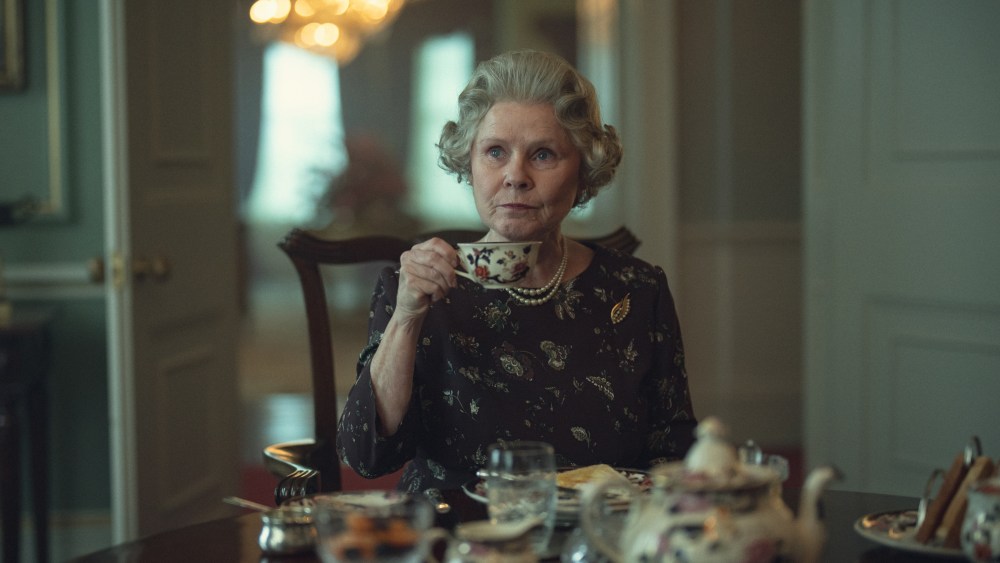There are two vacuums at the heart of the final installment of “The Crown,” which concludes this week with six episodes to round out its last season. The first is the death of Princess Diana (Elizabeth Debicki), whose final weeks, tragic car accident and funeral took up the entirety of the season’s first part, released last month. The second is the death of Queen Elizabeth II (Imelda Staunton), the series’ central subject. “The Crown” couldn’t capture the Queen’s 2022 passing on screen; creator Peter Morgan chose to end his magnum opus well before the present day. But the end of Elizabeth’s life naturally hovers over the end of a television show depicting the first half-century of her reign.
Perhaps inevitably, then, the home stretch of “The Crown” is shaped more by what it does not or cannot portray than what the audience actually sees. Since the introduction of Emma Corrin as the future Princess of Wales in Season 4, Diana has dominated the entire back half of “The Crown,” a decade-by-decade dramatization of the British monarchy from the aftermath of World War II to the 21st century. Her sudden absence from the show leads to a sense of disorientation, echoing the emotions the world experienced in unison over 25 years ago. Without this beacon of charisma, “The Crown” feels quiet — its colors muted, its volume dimmed. The mood is both true to the post-Diana moment and a less-than-ideal note on which to end a project of such ambition and scope.
It doesn’t help that Morgan has restricted himself to a moment with major milestones that lack the fizz of a tabloid scandal or the sorrow of a premature death. For that, Morgan would’ve had to extend the show into the late 2010s, when American actress Meghan Markle made a seismic impact on the royals rivaled only by that of her mother-in-law. Instead, “The Crown” works with what’s available: the courtship of Prince William (Ed McVey) and Kate Middleton (Meg Bellamy) at university in Scotland; the death of Princess Margaret (Lesley Manville) due to complications from a stroke; and the marriage of Prince Charles (Dominic West) and Camilla Parker-Bowles (Olivia Williams) after decades of partnership.
None of these events come close to rivaling Diana’s enduring hold on the zeitgeist, a fact “The Crown” implicitly acknowledges in how it divvies up its time. Part 1 of the season, focused almost exclusively on the Princess, took place over just eight weeks; Part 2 practically zips ahead from William’s post-funeral return to Eton through the turn of the millennium, the onset of the Iraq War and finally Charles’ nuptials. This last chapter spans nearly a decade in all, stretching its focus from the royals’ tenuously optimistic future (William and Kate) to its firmly concluded past (Elizabeth and Philip — the latter of whom, as played by Jonathan Pryce, all-too-literally deems the couple a “dying breed.”)
The unique structure of “The Crown” poses a particular dramatic challenge. Like Charles and Diana’s generation of royals before them, Morgan has to cultivate William and his brother Harry (Luther Ford) into proper protagonists, a tricky baton to pass when the audience already knows our time with them is limited. There just isn’t enough room to develop either prince, let alone both, into a fully realized character. The most interesting moments are an extension of Diana’s arc: a grief-stricken William lashes out at his father, while Carole Middleton (Eve Best) is positioned as a more successful version of Mohamed al-Fayed (Salim Daw) — an overbearing parent who cajoles and coaches their child into a high-profile relationship. (The Middletons, at least, don’t have to fight an uphill battle against anti-Arab racism.) But William, Harry and Kate themselves never come into focus, with the script often leaning on vague allusions to the brothers’ future discord to fill in the gaps. Of the three, only William gets a whole episode. Harry’s infamous Nazi Halloween costume is a tertiary subplot in the series finale, with a reference to joining the military the only half-hearted attempt to tie off his thread.
Instead, “The Crown” puts Elizabeth back into the spotlight after several seasons that saw the monarch in a more marginal role. The Queen’s grandsons feel underserved in part because “The Crown” has to balance the beginnings of their story with the end of their matriarch’s. The good news is that the show is better suited to the latter task; the bad news is that in making a closing argument, “The Crown” revisits some of its most conservative, least sexy themes. Like Gillian Anderson’s Margaret Thatcher before him, Tony Blair (Bertie Carvel) acts as a natural foil, a reformer who forces Elizabeth to defend the status quo she represents. When the textbook neoliberal suggests eliminating roles like the royal swan keeper in the name of fiscal restraint, Elizabeth argues that “tradition is our strength.” Her subjects, she says “want to feel like they’ve entered another realm,” so it’s “our duty” to create a transportive, politically neutral sense of otherworldly hauteur. “The Crown” gently acknowledges how ridiculous this can look in practice: “Few have truly mastered the Dutch bonnet napkin fold,” one servant solemnly intones. But it’s still deeply sincere.
That sincerity shines through in the final episode, an explicit meditation on mortality and legacy. “The Crown” has allowed critics of monarchism — Thatcher, Blair and Diana chief among them — to have their say. But it’s Elizabeth who gets the last word, and whether you agree with her perspective or not, the final moments of “The Crown” are an articulate expression of why ritual, stasis and pageantry matter. From the beginning, “The Crown” has worked to make compelling drama from ingredients that are often its antithesis: consistency over novelty, obligation over desire, stoicism over expressiveness. If it hasn’t always succeeded, “The Crown” at least concludes as the truest version of itself.
All six episodes of “The Crown” Season 6 Part 2 are now streaming on Netflix.
